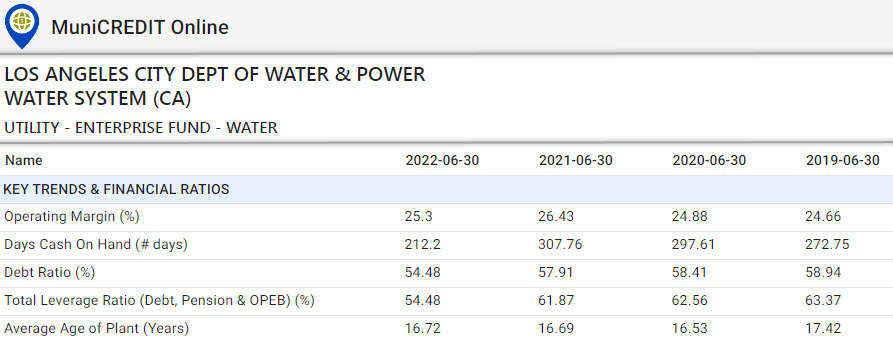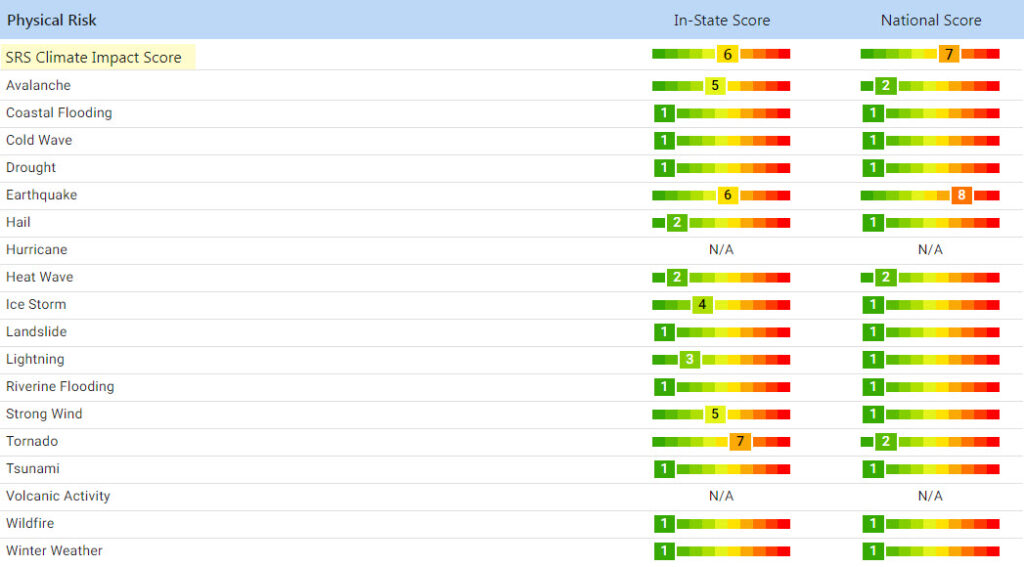Resources
MuniESG Insights | Los Angeles Water System: Climate & Transition Risk Profile
The Los Angeles water system, like other water utilities in the West and Southwest, can be subject to supply risk resulting from climate change. We look at the ESG challenges and financial position of this water utility.
June 6, 2023
The City of Los Angeles Department of Water & Power (LADWP) recently came to market with a $495.53 million 2023 Series A Water System Revenue bond issue. The Water System (System), the largest municipal utility in the country, supplies water to about 3.8 million city residents within a 473 square mile service area. We examine the current ESG challenges facing this massive utility system.
Financials
A quick review of the System on our web-based MuniCREDIT Online shows why it has earned strong ratings of Aa2 (stable)/ AA+ (stable)/ AA (stable) from Moody’s, S&P and Fitch, respectively.

Table 1.
Physical Risk Exposure
DPC DATA recently expanded its ESG Risk coverage beyond State and local governments to include municipal utility enterprises.
As an enterprise fund of the City of Los Angeles, the Water System shares the City’s climate risk profile, as shown in Table 2.

Table 2.
Based on the ESG scores compiled by our partners at Spatial Risk Systems (SRS), the Los Angeles Water System has a rather moderate Climate Risk profile versus its peers, both in-State and nationwide, with the obvious exception of Earthquake Risk. (Note that the “Drought” scores provided by SRS only take into account potential agricultural industry losses from climate events, not the overall impact of drought on the entire local economy).
Drought conditions obviously represent one of the most significant, if not the most significant, risk factor facing water systems in the Western and Southwestern states.
According to a 2013 report by the USC Center for Sustainable Cities, the City of Angels gets its water from three main sources: the Owens River in Eastern California, and the Colorado River, and groundwater. As of FY2022, about 73% of Los Angeles’ water comes from the Metropolitan Water District of Southern California (MWDSC), a regional water distributor, through the Colorado River Aqueduct.
A River in Crisis
The Colorado River, the source of water for seven Western states, including some of the fastest-growing in the nation, has been in crisis mode as two decades of drought conditions has diminished supply in the face of rising demand. In fact, the three years of the 2020-2022 Drought were the three driest years ever recorded in California.
Last month, the seven states missed the deadline to come up with a new water use compact, leading to a federal government threat to impose drastic water allotment cuts to meet the river’s declining capacity.
Fortunately, since December 2022, a series of severe rainstorms came through the State and provided a temporary break from the relentless drought conditions. This allowed the states that depend on the Colorado River to reach a new agreement on water use reductions on May 22, 2023, at levels that are much less severe than those initially proposed. The agreement is now under review by the US Bureau of Reclamation.
To address supply reliability concerns, the Los Angeles Water System has been diversifying its water sources and investing in conservation and water use efficiency programs. These steps resulted in a 4% decline in water demand from 2018 to 2022. Recycled water accounted for a minor 2.4% of total supply in 2022, still up from 1.9% in 2018.
Ironically, any reduction in water sales from conservation efforts would impact the System’s financials, unless management can adjust its cost structure to match sales shortfalls. In the short term, LADWP does have the flexibility of reducing its purchased supply expenses by receiving less water from MWDSC.
Transition Risk Exposure
Given its scale and the size of its service area, LADWP’s Water System should not have any problem addressing any potential cost resulting from the transition to a Net Zero economy, as shown in Table 3.

Table 3.
In terms of Estimated Carbon Emissions relative to Sales, the System is in the middle of the pack, with a score of “5” as compared to other cities and towns within the Golden State. Otherwise, its estimated Carbon Transition Liability in relation to Net Capital Assets and Total Revenues compares quite favorably to other local governments within the State and around the country (scores of “3” or lower).
Conclusion
Until recently, the common wisdom in the municipal market has been to give municipal utilities a free pass on ESG risk factors due to the essential nature of their services. Many market participants now recognize that public utilities, regardless of their purpose, are economic entities that have their own carbon footprint and have significant exposure to “Environmental” risk factors, including climate-related factors. Water systems in the West and Southwest, such as the Los Angeles water system, can be subject to significant supply risk tied to climate change. No credit analysis of such essential purpose utility would be complete without an assessment of climate-related factors.
Note: for more details on our MuniCREDIT Solutions, which covers over 24,000 municipal obligors across all major sectors, and on our MuniESG scores, including details on the 18 sub-components of the Climate Impact Score (hurricanes, tornadoes, wildfire, etc.), please contact us at sales@dpcdata.com.
Disclaimer: This report is for informational purposes only and is not intended as an offer or solicitation with respect to the purchase and sale of any security. Although the information contained in this report has been obtained from sources we deem reliable, we do not guarantee its accuracy, and such information may be incomplete or condensed. Investors should obtain and read the official statements related to the securities discussed. All opinions are only valid as of the report date and are subject to change without notice.
Stay informed
Sign up and get the latest news and insights about DPC DATA’s municipal bond credit, disclosure, and compliance data solutions delivered right to your inbox.

